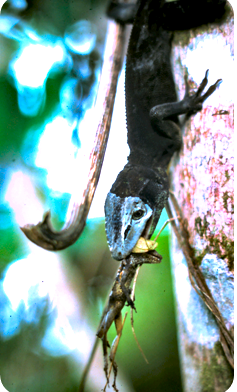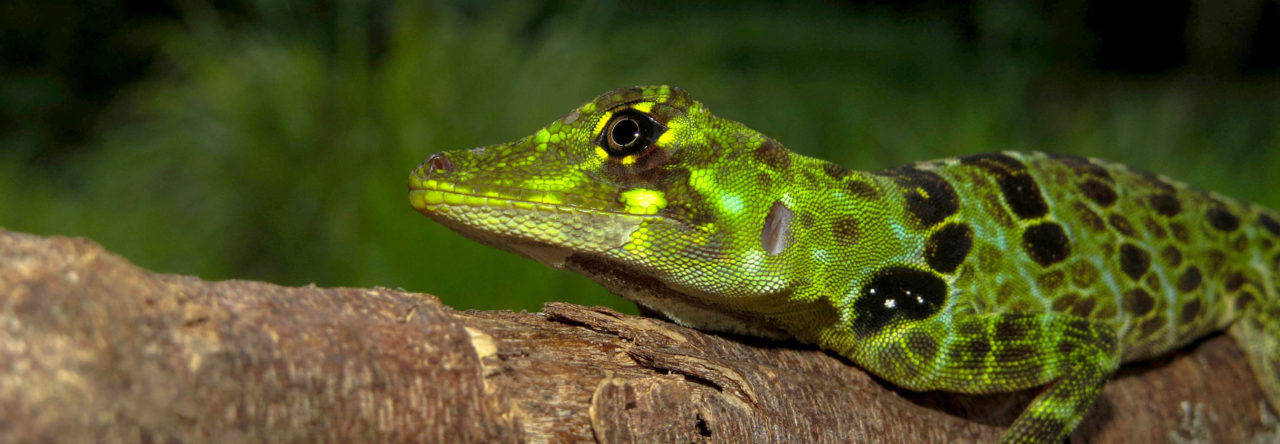 Three years ago I received a message from Ray Huey asking me if I’d be interested in collaborating on an NSF grant to return to Puerto Rico and replicate the studies on Anolis thermal biology and ecology that we had conducted during the 1970s. The idea was to have the original investigators, including Ray, myself, and Paul Hertz, work in the same study areas, utilize the same techniques, and document changes that had occurred over the past 35-40 years. Our ultimate goal was to understand the impact of climate warming on Anolis populations over a range of habitats, from the Luquillo rainforest in northeastern Puerto Rico to the Guanica dry forest in the southwestern corner of the island.
Three years ago I received a message from Ray Huey asking me if I’d be interested in collaborating on an NSF grant to return to Puerto Rico and replicate the studies on Anolis thermal biology and ecology that we had conducted during the 1970s. The idea was to have the original investigators, including Ray, myself, and Paul Hertz, work in the same study areas, utilize the same techniques, and document changes that had occurred over the past 35-40 years. Our ultimate goal was to understand the impact of climate warming on Anolis populations over a range of habitats, from the Luquillo rainforest in northeastern Puerto Rico to the Guanica dry forest in the southwestern corner of the island.
We eventually received NSF funding for the project, and to date I have carried out field work in Luquillo and Guanica during July 2011 and January 2012. Andres Garcia, my long term colleague from the National Autonomous University of Mexico, joined me in Puerto Rico as a co-investigator on the grant. At the Luquillo study site, we successfully repeated all phases of the research I conducted in July 1976 and January 1977 (Lister, B. C. 1981. Seasonal niche relationships of rainforest anoles. Ecology 62(6):1548-1560). The major components of this study were (1) a July and January census of forest dwelling anoles (A. gundlachi, A. evermanni, and A. stratulus) (2) measurements of perch heights, perch diameters, and perch site insolation (3) recording of body temperatures for all forest species (4) sweep samples of the forest understory during both the winter and summer seasons (5) collection of male and female A. gundlachi for subsequent scoring of reproductive condition and stomach content analysis.
 Comparison of our results with those of my previous study indicate significant changes in all of the above areas.
Comparison of our results with those of my previous study indicate significant changes in all of the above areas.
Read More




 Three years ago I received a message from Ray Huey asking me if I’d be interested in collaborating on an NSF grant to return to Puerto Rico and replicate the studies on Anolis thermal biology and ecology that we had conducted during the 1970s. The idea was to have the original investigators, including Ray, myself, and Paul Hertz, work in the same study areas, utilize the same techniques, and document changes that had occurred over the past 35-40 years. Our ultimate goal was to understand the impact of climate warming on Anolis populations over a range of habitats, from the Luquillo rainforest in northeastern Puerto Rico to the Guanica dry forest in the southwestern corner of the island.
Three years ago I received a message from Ray Huey asking me if I’d be interested in collaborating on an NSF grant to return to Puerto Rico and replicate the studies on Anolis thermal biology and ecology that we had conducted during the 1970s. The idea was to have the original investigators, including Ray, myself, and Paul Hertz, work in the same study areas, utilize the same techniques, and document changes that had occurred over the past 35-40 years. Our ultimate goal was to understand the impact of climate warming on Anolis populations over a range of habitats, from the Luquillo rainforest in northeastern Puerto Rico to the Guanica dry forest in the southwestern corner of the island.



















